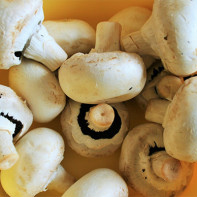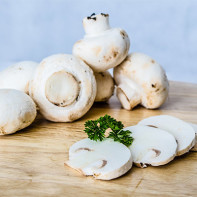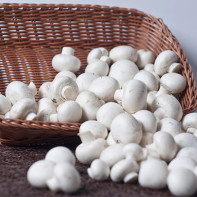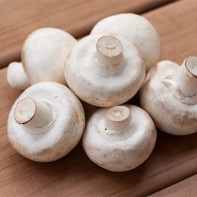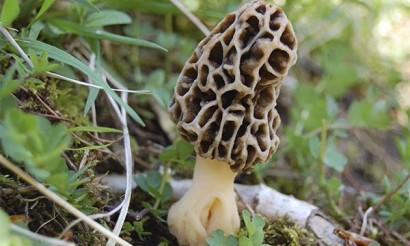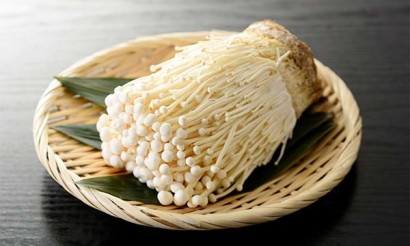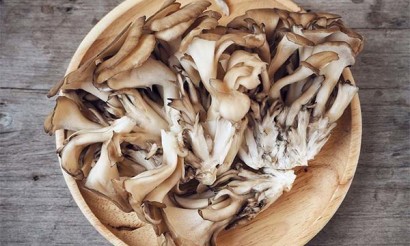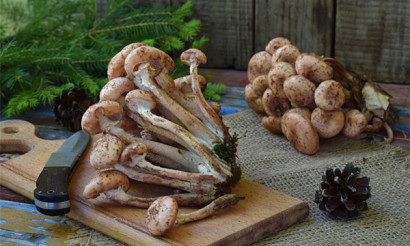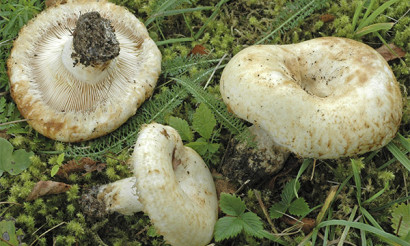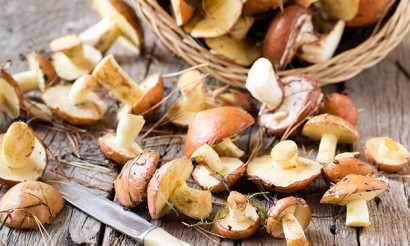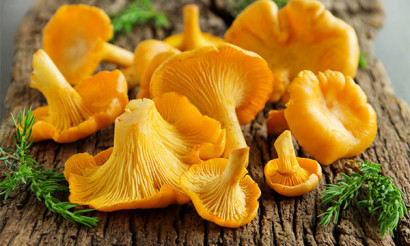Champignon mushrooms: useful properties and recipes for cooking
Champignon is considered one of the most popular mushrooms in culinary and is cultivated in more than 70 countries. History is silent about the exact time of "domestication" of these mushrooms. But it is known that since 1754 mushrooms began to be grown in greenhouses.
- What mushrooms look like and where they grow
- Types
- Pale grebe and mushrooms: similarities and differences
- Composition and calories
- How to use mushrooms
- General benefits
- For Women
- For Men
- While Pregnant
- For breastfeeding
- For children
- Is it possible to eat mushrooms when losing weight?
- Mushrooms in medicine
- Diabetes
- For pancreatitis
- For gastritis
- For gout
- For cholecystitis
- Harms and contraindications
- Can you be poisoned by mushrooms?
- How to choose and store mushrooms
- Can I freeze?
- How to cook champignons: Recipes
- How to roast them
- How to boil them
- Mushroom caviar from champignons
- Shish kebab of champignons
- How to cook mushrooms in the oven
- How to boil mushroom soup
- How to marinade
- Do I have to peel mushrooms before cooking them?
- How to eat mushrooms properly
- Can I Eat Browned Mushrooms?
- Can I Eat Raw?
- Can we give mushrooms to animals?
- Interesting Facts about Mushrooms
What do champignons look like and where do they grow?
Champignons have white or brownish caps, about 10 cm in diameter and shaped like a hemisphere. The cap is velvety and may sometimes have small scales. The mushroom stalk is about 7-9 cm high and has the same color as the cap. There is a ring in the middle of the stalk. The pulp is white in color.
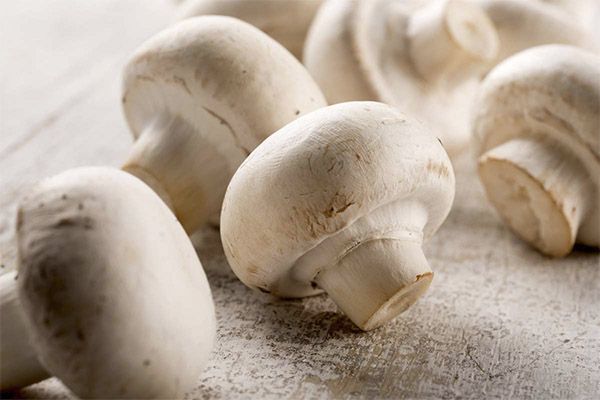
Mushrooms grow vigorously from May until almost mid-autumn. They are common on the European continent in temperate latitudes. They are quite tough mushrooms, as they can develop pressure of 7 atmospheres, which helps them break through hard soil.
Types
The main types of mushrooms are:
- Overgrown. The mushrooms are found in forested areas. The cap is 5-10 cm in diameter and the color is light grayish. The length of the stem - 7-9 cm, thickness - up to 1 cm, has a cylindrical shape, light color, light yellowish ring. The flesh has an anise odor. Thin, frequent laminae can be pinkish, purplish or brown.
- Yellowcap mushroom. The mushroom is poisonous and usually grows among grasses in fertile soil. They can often be found in a park, in a field, or even near a dwelling. The cap is 7-15 cm in diameter, has a hemispherical shape and concave edges. Later the shape becomes flat-round, prostrate, sometimes with a convex center. The light-colored cap may turn yellow, covered with brown or brownish spots. The stem is about 7 cm long and 1-2 cm thick, with a double ring. The light flesh is yellow after cutting, and has an inky odor. Frequent light or pink-gray plates can take on coffee-milk and purple coloration.
- Reddish. Grows in areas of mixed forests and parks. The cap is 5-10 cm in diameter and has a spherical shape, later convex. The cap is light-colored with a reddish or brown middle. The stem is 5-10 cm long and 7-15 mm thick and has a white, pinkish ring. The light flesh has a nutty flavor. Frequent laminae during growth transform from pinkish to brownish, purple color.
- Pink-plastid. Found in forests, parks, and near housing. The cap is 4-8 cm in diameter, light brown or light colored, laminae pink, spherical or bell-shaped, margins concave. The smooth, hollow stem is 3-7 cm high and 3-9 mm thick, with a white ring. The light flesh may have a yellow tint.
Pale grebes and mushrooms: similarities and differences
Similarities: Both mushrooms have almost the same size. The height of the stalk is on average 10-15 cm. The diameter of the cap is about 15 cm. The mushrooms also have similar rings on the stalk.
Differences:
- One of the differences is the size of the base of the mushrooms. Inedible species have a thin, soft stalk, while the edible champignon has a thicker, firmer stem.
- Mushrooms can also be distinguished by the color of the cap. The caps of grebes are lighter both above and below, unlike the caps of edible mushrooms, the lower part of which has a pinkish color. The cap of grebes may sometimes change color from white to light green.
- The mushrooms can also be distinguished by their smell. The inedible ones have no smell at all, while the edible ones have a slightly almond-like aroma.
- Worms do not spoil the flesh of mushrooms. Edible mushrooms may have traces of the presence of worms.
Composition and calories
One hundred grams of the product contains:
- calories - 27 kcal;
- proteins - 4.3 g;
- fats - 1 gr;
- Carbohydrates - 0.1 g.
In addition, the product contains vitamins B, D, E, PP. Mushrooms are also rich in calcium, potassium, selenium, zinc, copper, manganese, phosphorus, iron and essential amino acids.
What are the usefulness of champignons
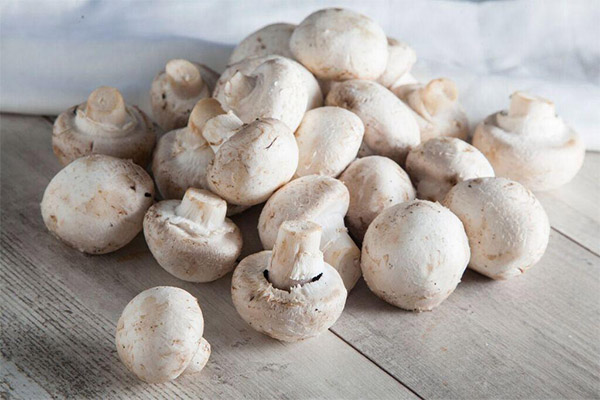
General benefits
- They are a source of selenium. In mushrooms it is quite a lot of this substance. Selenium has antitumor, antioxidant and anti-inflammatory potential and can reduce the risk of cancer, thyroid disease, affect cognitive function.
- Regulate cholesterol levels. Mushrooms provide the body with high-quality proteins, while containing almost no fats or carbohydrates. Fiber, along with enzymes, helps regulate cholesterol levels in the body. In addition to controlling cholesterol, substances in mushrooms help get rid of it during digestion. Balance cholesterol levels between LDL (bad cholesterol) and HDL (good cholesterol) is essential for the prevention of cardiovascular disease, atherosclerosis, heart attacks and stroke.
- Maintain bone health. This type of mushroom is an excellent source of calcium. It is an important nutrient involved in the formation and strengthening of bone tissue. Consistent intake of calcium in the body will be beneficial for the overall health and help reduce the risk of osteoporosis, as well as reduce joint pain, improve their mobility and prevent bone degradation.
- They are a source of vitamin D. This is a substance that is not often found in foods, so its presence in food makes it automatically more valuable. This vitamin is present in mushrooms and helps the body to better absorb calcium and phosphorus, and normalizes the overall metabolism. Calcium and phosphorus are also present in mushrooms in sufficient quantities, so the combined effect of the presence of all these nutrients makes this product especially valuable for health.
- Strengthen the immune system. Ergothioneine, a powerful antioxidant present in mushrooms, acts as a defender of the body against the effects of free radicals and helps strengthen the immune system. Ergothioneine destroys free radicals, dangerous compounds that are released during metabolic processes and travel throughout the body, causing significant damage that leads to various diseases. Mushrooms contain natural antibiotics that inhibit the growth of germs and fungal infections. The polysaccharides contained in mushrooms stimulate and regulate processes related to the functioning of the immune system.
- They normalize blood pressure. Mushrooms contain potassium, among other things. Potassium can act as a vasodilator. It helps relieve stress on the blood vessels and therefore helps to lower blood pressure. High blood pressure has negative effects on the body because it provokes heart attacks and strokes. Potassium also improves cognitive function because increased blood and oxygen flow to the brain stimulates nervous activity. Studies have shown that enough potassium in the body improves memory.
- Improve the absorption of iron. Copper, found in mushrooms, also has beneficial effects on the body. Copper deficiency can lead to anemia or neutropenia. This is because copper regulates and stimulates the absorption of iron. In addition, mushrooms contain sufficient amounts of iron, so the symbiosis of these substances even more effectively helps maintain bone health and prevents the occurrence of anemia.
- Prevent cancer. Mushrooms contain compounds that help reduce the risks of certain cancers. For example, lectin helps to slow the growth, development and spread of cancer cells. Women who regularly consume mushrooms are less likely to get cancer than those whose diet does not include these mushrooms.
- Maintain healthy skin and hair. Nutrients (selenium, copper, biotin, niacin and riboflavin) contained in mushrooms help maintain healthy skin and hair.
For women
Mushrooms have beneficial effects on the female body. Regular consumption of mushrooms contributes to a significant reduction in the risk of cancer. In addition, it has been found that mushrooms can prevent early aging, the appearance of wrinkles, and this product also supports a healthy complexion. As part of mushrooms contain powerful antioxidants - selenium, often used as one of the main components of anti-aging cosmetics, as well as pantothenic acid, which has properties of skin cell regeneration.
For men
In the composition of mushrooms with a small number of calories almost no fat, so they are very effective in helping to lose weight and gain muscle mass. Sometimes mushrooms can even replace meat, since the product is rich in fiber and proteins. In addition, mushrooms contain selenium - an ally of the body in the fight against prostate cancer. Diets rich in potassium and low in sodium reduce the risk of cardiovascular disease. Adding mushrooms to the diet can have beneficial effects on the reproductive system. Mushrooms help inhibit estrogen production and contain enzymes that help maintain high testosterone levels.
When pregnant.
It is not recommended to consume mushrooms during pregnancy, but in case of a strong desire, it is allowed to eat a small portion of store-bought mushrooms. They have a number of useful properties, which have a positive effect on the health of the future mother. Mushrooms can provide the body with vitamins D, B, iron, protein, fiber and antioxidants, which are necessary for women and the growing fetus. That said, it's worth noting that improperly cooking mushrooms can be detrimental to a woman in the position.
When breastfeeding
Mushrooms are a dietary product. It has almost no fats and sugars, but it contains vitamins and minerals that the body needs during breastfeeding. This zinc, potassium, iron, iodine and phosphorus, vitamins B, C, D and E. Thiamine reduces the likelihood of headaches that women may suffer from in the postpartum period, and riboflavin supports normal liver function and is involved in the processes of hematopoiesis. Amino acids (lysine and arginine) regulate blood pressure, participate in the process of growth hormone production, support brain activity, metabolism and contribute to more efficient removal of toxins from the body. In the postpartum period it is a good idea to eat light meals. Mushrooms can be boiled or stewed, but they should not be pickled or fried, because the fats and acids can have a negative impact on the body of the mother and baby.
You can introduce mushrooms into your diet when your baby is 4 months old. In the case of liver or gallbladder problems, you should refuse to eat this product.
For children
Since mushrooms are not easily digestible, many people consider this product unsuitable for children. Useful substances are mostly contained in the cap of the mushroom, and the components that can harm the child's body are more present in the stalk. In addition, if we are talking about wild mushrooms, they can often contain dangerous substances derived from the soil, so children are advised to give only store products. You should not include mushrooms in the diet until the child is 5 years old.
Is it possible to eat mushrooms when losing weight
Champignons are quite often used as an ingredient in dietary dishes. This product is used both in the period of active weight loss and in the period of unloading, because it contains almost no calories, fats and carbohydrates.
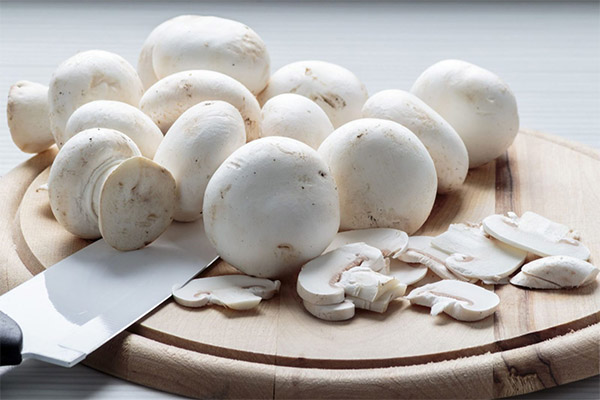
Champignons support the figure, because more than 85% consist of liquid. With a small amount of fat, they can satisfy hunger quite well. The protein in mushrooms is great for burning fat. With daily consumption of mushroom dishes, you can effortlessly lose a few pounds. And if after losing excess weight you need to maintain the shape and fix the result, then the regular consumption of mushrooms is a great help in this. Plant fibers are involved in metabolic processes and give a feeling of fullness. Mushrooms also give energy. For effective weight loss, it is better to use fresh product or boiled.
Champignon mushrooms in medicine
In the field of folk medicine, various mushroom tinctures and extracts are quite popular, which help to fight ulcers and promote wound healing. In addition, they can be used as an ingredient in cosmetics and facial masks. Mushrooms are not used in the field of traditional medicine. Mushrooms can act only in the role of an authorized or prohibited product.
In case of diabetes.
Champignons are considered a very suitable food for diabetics. They have no fat, no cholesterol, very low carbohydrates and high protein content. In addition, they contain a lot of water and dietary fiber. It is worth focusing on the fact that this product contains natural insulin, as well as enzymes that help in the breakdown of sugar.
Mushrooms are also known to contain compounds that support normal functioning of the liver, pancreas and other endocrine glands, thereby promoting insulin formation and its proper regulation throughout the body. The natural antibiotics in mushrooms can help protect the body from potentially life-threatening conditions in diabetes.
Important: The glycemic index of mushrooms is 15 units.
In pancreatitis
At exacerbation, it is forbidden to eat mushrooms, because the substances they contain are very difficult to digest, which leads to bloating and painful cramps. In addition, it is difficult to absorb many useful substances, including proteins. Pancreatic enzymes are also secreted and gastric juice is produced, which can provoke bouts of pain, nausea, and vomiting.
In persistent remission, mushrooms are also forbidden. But if there is a great desire, it is possible to include this product in your diet, but you need to adhere to recommendations that will minimize the negative consequences. You can begin to eat mushrooms after a year after the acute phase of the disease, and only in the case of a mild course of the disease. It is necessary to use cultivated store mushrooms. At the first intake, you should not eat more than 1 teaspoon. After use, you need to monitor your condition and in case of side effects, exclude the product from the menu. You can eat no more than 2-3 mushrooms at a time (once every 2 weeks). Before cooking mushrooms should be well washed. Boiled and mashed mushrooms are considered a safe option. Frying and pickling mushrooms is not allowed.
If you have gastritis
It is forbidden to eat mushrooms of this type in case of gastritis. The main reason for the ban is that in the case of such diseases the body is contraindicated hard-to-digest products, including mushrooms. In addition, you should not consume mushrooms of this type because:
- They contain a lot of chitin. Chitin - this is a difficult substance to digest, which can provoke the weakening of the assimilation of other substances, so the overall benefit of the product can be completely nullified.
- Due to the difficult digestion there is an increased stimulation of gastric juice production, which in turn can lead to a worsening of the disease.
- During their growth, mushrooms absorb toxins and radioactive substances from the environment. Considering the fact that today many areas are contaminated by industrial waste, we can conclude that most of the mushrooms are potentially a threat to healthy people. At the same time, the threat multiplies in the case of gastritis.
It is worth noting that there are exceptions to this issue. If people have a great desire, in case of a stable prolonged remission, it is possible to consume weak mushroom broths in small quantities. At the same time, it is important to remember that from the cooked broth mushrooms should be removed, this will help reduce their harmful effect. If we talk about mushrooms in fried form, it is strictly forbidden to eat them. If you do decide to eat mushroom broth, you should drink a stomach medication 30 minutes before eating. This will help the food to digest better, preventing the occurrence of heaviness after eating.
In case of gout
Mushrooms are delicious and low in calories, but unfortunately, people who suffer from gout should very much limit themselves in their consumption. Mushrooms help to increase the amount of uric acid crystals in the joints. In addition, mushrooms in their fresh form contain other prohibited substances, so they are not recommended for consumption with gout. Mushroom soups, sauces and broths can provoke a worsening of the disease.
In cholecystitis
When cholelithiasis, it is forbidden to eat any type of mushrooms, including mushrooms. In addition, it is not allowed to consume broths based on mushrooms, as this can negatively affect the course of the disease, and in some cases provoke a relapse.
Harms and contraindications
Champignons are mushrooms that can have negative effects on the body and even seriously harm your health. They contain a large amount of chitin, a component which is quite difficult to digest, especially when it comes to children's bodies. In addition, chitin also affects the processes associated with the assimilation of nutrients that are present in mushrooms.
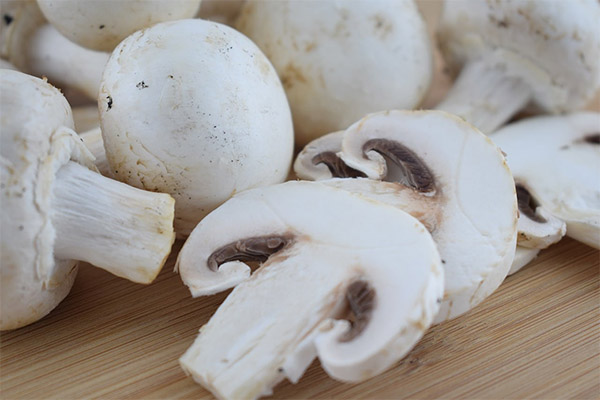
Another thing to pay attention to is the environment of the mushrooms during their active development. This is important because mushrooms absorb all the toxins that are in the soil or in the air. It is also worth noting that the excessive use of this product can cause various inflammations in the gastrointestinal organs.
Can poisoning by mushrooms
Champignons, like other types of mushrooms, can be poisoned. Poisoning is often very dangerous, sometimes can cause serious health problems up to and including death. It is recommended to buy the product only in the store, and it is important to pay attention to the quality. Before using the mushrooms should be thoroughly rinsed.
Symptoms
Symptoms of mushroom poisoning:
- cold sweats;
- Headaches, dizziness;
- nausea, vomiting;
- apathy, weakness in the body;
- hallucinations;
- yellow discoloration of the skin;
- diarrhea;
- blurred vision;
- acute cramps and abdominal pain.
How to pick and store mushrooms
When choosing mushrooms, the first thing to pay attention to is their color. Fresh product will have a white-brownish or completely white color. Lighter color mushrooms will be stored longer, and they can better preserve their useful properties. It is advisable to choose mushrooms with a sealed, unbroken membrane that connects the stalk to the cap.
Mushrooms can be stored for about 5 days (in the refrigerator). Check mushrooms periodically during storage, as they may become moist and slippery. If a mushroom has opened and darkened on the inside, it should be used as soon as possible.
Can I freeze them?
Champignons can be frozen. Since mushrooms are perishable, they must be used as soon as possible after purchase. If this is not done, the mushrooms can turn black and quickly become inedible. But sometimes it happens that purchased mushrooms need to be left for some time to preserve. In this case, you can subject them to freezing, the main thing - do not wash them before placing them in the freezer, so they do not absorb the liquid.
How to cook mushrooms: recipes
Champignons are widely used in the field of cooking. The mushrooms can be used as an ingredient in a variety of dishes. They can give great flavor to soup, salad, sauce, soufflé, gravy and even pie. Mushrooms can be used roasted, stewed, pickled, boiled, dried, and baked. Champignons go well with fish and meat, seafood, various cereals, as well as vegetables and eggs.
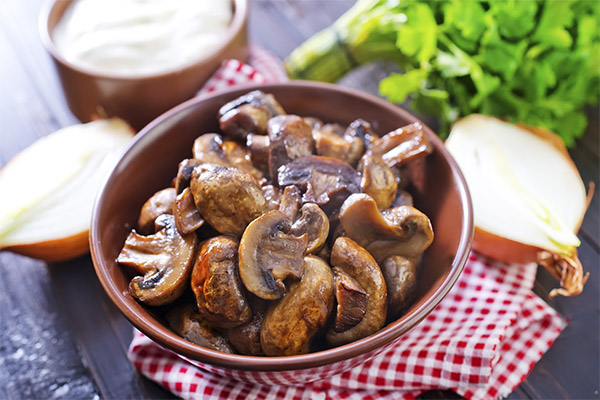
It is not recommended to use them with dairy products or nuts. In addition, mushrooms should not be mixed with potatoes, as this can lead to problems of the digestive system.
How to fry
Ingredients:
- mushrooms - 550 g;
- onion (onions) - 1 pc;
- Oil (vegetable) - 50 g.
How to cook:
- Peel the pulp of mushrooms under the cap, remove dirt and black spots from the product. In a colander quickly rinse the mushrooms, wait for the water to drain.
- Cut the mushrooms into large chunks.
- Slice the onion (rings in 4 pieces).
- Heat a skillet over medium heat with vegetable oil. Saute until onions are golden (about 2 minutes).
- Place the mushrooms in the pan, pepper and salt (to your personal taste) and stir. Fry over medium heat, stirring occasionally.
- Roast for about 10 minutes until all the moisture has evaporated. After that, leave to roast for another 3 minutes to allow the mushrooms to blush.
- At the end, you can add a clove of garlic (optional).
How to boil
To boil mushrooms, you can use a pot or a saucepan.
- Pour water into the selected container. You need enough water so that after adding the mushrooms, it can completely cover them.
- Put the water on the fire, and salt it. Peel mushrooms and cut them into 2-4 pieces.
- Place mushrooms in boiling water. After boiling, you need to reduce the heat and gently, taking your time, put the mushrooms into the pot, then cover the container with a lid.
- Wait for boiling, reduce the heat and continue to cook, periodically removing the foam.
- After cooking, strain the mushrooms with a colander.
Champignons should be boiled for about 5 minutes (counting from the moment of boiling water with mushrooms).
Mushroom caviar from champignons
Ingredients:
- mushrooms - 500 g;
- carrots - 1 pc;
- onion - 1 pc;
- Vinegar - 1 tbsp.
How to cook:
- Wash the mushrooms well and let them dry. Then slice them.
- Peel the onion and carrot. Grate carrots (finely).
- Cut onion into half rings or cubes.
- Pour oil into a frying pan and put it on the stove over low heat. Spread onion and carrot on it.
- When the vegetables soften (after 8-10 minutes), put the mushrooms in the pan and stir.
- Salt, pepper (add spices and bay leaf if desired).
- Start frying the mushrooms (about 10 minutes), stirring occasionally.
- Remove the mushrooms from the stove and allow them to cool (remove the bay leaf). Transfer the mushrooms to a bowl (deep), leaving the excess liquid in the pan.
- Process fried mushrooms with a hand blender to a mushroom pulp.
For better storage of caviar, you can add table vinegar. Put the caviar in a jar, cover and store in the refrigerator.
Mushroom kebab
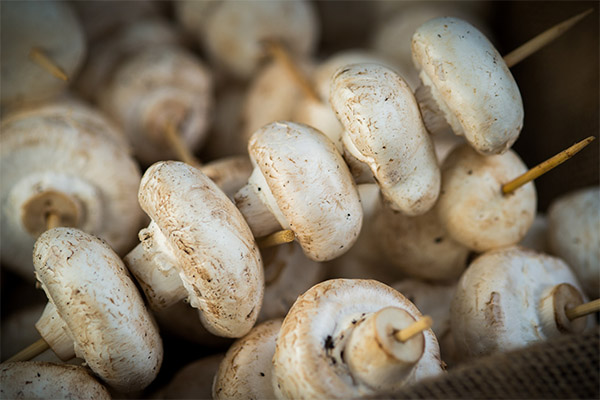
Ingredients:
- champignons - 300 g;
- oil (vegetable) - 2 tbsp;
- soy sauce - 2 tbsp;
- lemon juice - 1 tsp;
- paprika (sweet) - 0.5 tsp.
How to cook:
- Wash and pat dry the mushrooms, put them in a plastic bag. There add chopped dill, paprika and 1 head of garlic (chopped).
- Pour soy sauce, oil and lemon juice directly into the bag.
- Tie the bag and shake it well. Then leave it for 12-15 minutes.
- Then string the mushrooms on skewers.
- Preheat the oven to 210-230C. Put the threaded mushrooms in it and bake for about 15 minutes. After that, the dish can be served.
How to cook mushrooms in the oven
Ingredients:
- mushrooms - 1 kg;
- mayonnaise - 3 tbsp;
- salt - 1 tbsp;
- pepper (black) - 0.3 tsp;
- mustard - 1 tsp.
How to cook:
- Wash the mushrooms, wait for the water to drain. Mix all the ingredients and put them in a bowl with the mushrooms.
- Mix well and let marinate for 1 hour.
- Place the mushrooms on a baking tray (covered with foil) so that the legs are at the top.
- Put into a preheated oven up to 200C for 30 minutes.
- After cooking, sprinkle mushrooms with garlic (chopped) or herbs.
How to cook mushroom soup
Ingredients:
- water - 1,5 l;
- mushrooms - 5 pcs;
- potatoes - 2 pcs;
- carrots - 1 pc;
- onions - 1 pc;
- Oil (vegetable) - 2 tbsp.
How to cook:
- Cut carrots (julienne) and chop onions.
- In a pan put the vegetables and fry in oil.
- Coarsely chopped mushrooms add to the pot and fry (about 3 minutes).
- Peeled and diced potatoes put in a pot, pour boiling water and put on the fire.
- When the soup is ready, salt it, and you can put the greens.
How to marinade
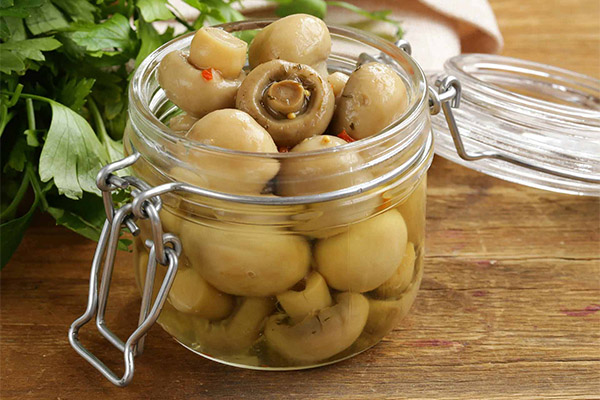
Ingredients:
- mushrooms - 500 g;
- water - 50 ml;
- vegetable oil (refined) - 50 ml;
- garlic - 3 cloves;
- vinegar - 2 tbsp (5%);
- bay leaf - 2 pcs;
- sugar - 1 tsp.
How to cook:
- Pour the water into a pot. Then salt, pepper add vinegar, bay leaf, sugar, garlic and oil.
- Place washed mushrooms in a saucepan, put to boil on medium heat. After boiling, simmer for 5 minutes.
- Remove the mushrooms from the heat, let them cool, and then you can serve them.
Do I have to peel mushrooms before cooking?
Many people think that it is not necessary to peel mushrooms, because even in restaurants they are sometimes served raw. Sometimes uncleaned mushrooms are acceptable for cooking, but in any case, you should at least wipe them with a wet cloth or towel. In general, it is highly recommended to rinse the mushrooms well. Rinsing will be the best option, as unwashed mushrooms can pose quite a serious danger to humans.
How to eat mushrooms correctly
Champignons can be eaten raw, fried, stewed, boiled, the most important thing is that the product is of high quality. It is desirable to buy them in the supermarket and make sure that the product has no external flaws.
Is it possible to eat blackened mushrooms?
It is important to determine the nature of the darkening of mushrooms. If the darkening is evident on the cap of the mushroom, but the color when you break the inside remains normal, then such a product is allowed to eat. If the plates in the lower part are dense and slightly darkened, they can also be cooked. And if the plates have a rich dark color and at the same time they are a little wet and slimy, then such mushrooms are better not to eat.
Can you eat them raw?
If we talk about greenhouse mushrooms, they can be eaten raw, which cannot be said about forest mushrooms. They very often accumulate in themselves harmful toxins for the body.
Can we give mushrooms to animals?
Mushrooms are not digestible in the stomach of animals. It is quite a heavy product, so it is not recommended to give it to pets. In addition, mushrooms can cause poisoning or cause digestive disorders. It is better not to take the risk of offering pets mushrooms or dishes based on them, as this product is not natural for them. It is not known what effect it will have on their body.
Interesting facts about mushrooms
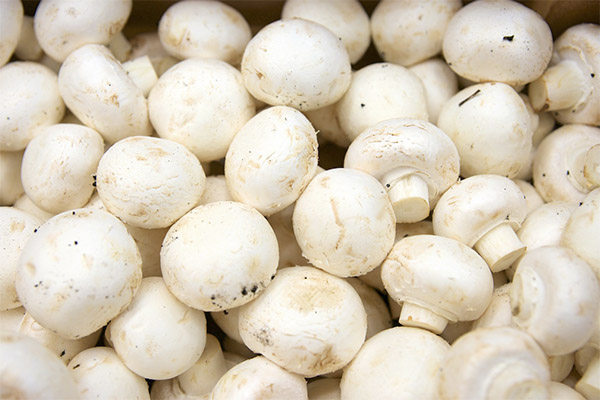
- Mushrooms were first discovered about a thousand years ago. According to studies, they were first used by the inhabitants of Italy, eating them with food, and later began to engage in cultivation. Champignons are considered to be almost the first mushrooms that began to be grown in an unnatural environment.
- The mushrooms became popular throughout Europe only in the 18th century. In addition, in the French capital at one time mushrooms were considered a delicacy, so this product was quite expensive.
- Some kings, who lived on the European continent, had special cellars, equipped as rooms for growing and cultivating a special kind of mushrooms, which were intended only for high ranks.
- Champignons are so popular that they are consumed even in those countries where this product is not revered.
- The largest exporters of mushrooms are the United States, France and the United Kingdom, with the greatest popularity in Poland.
- The product is quite widely used in the field of medicine. The mushrooms can help with conditions such as bronchitis and diabetes. Also, the substances in them can relieve headaches, treat hepatitis and tuberculosis. In addition, mushrooms can be used to make various extracts, which are very effective for skin problems.
- Mushrooms are also widely used in the field of cosmetology. In some countries there are beauty salons offering various masks, creams, lotions and other beauty products, in which the main ingredient is the mushroom. Such beauty products are usually quite expensive.
«Important: All information on this site is provided solely for introductory For educational purposes. Before applying any recommendations, please consult with a specialized specialist before applying any recommendations. Neither the editors nor the authors shall be liable for any possible harm caused by materials."

